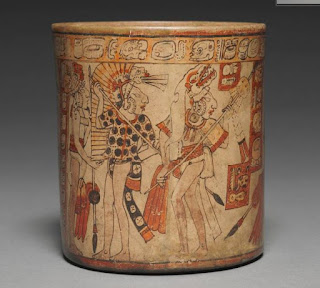Some History Behind the Cleveland Museum of Art’s “Vessel with Battle Scene” or “Maya War Vase”
 |
| Vessel with Battle Scene. Cleveland Museum of Art. |
The Cleveland Museum’s newly acquired “Vessel with Battle Scene” appears to be the Maya War Vase or Merrin Vase cataloged at Kerr archive number 2352. It is evident that the two are the same. But this information is unconfirmed in the museum’s press release.
The Cleveland Museum’s August 13, 2012 public statement begins and ends the collecting history of the vessel by saying that the archaeological artifact was in the Edward H. Merrin collection in New York by 1973 and is now in the museum’s holdings:
“This exceptional artwork, Vessel with Battle Scene, is one of several polychrome cylinder vessels known as the Fenton Group, painted by the same Maya master artist in the Nebaj region of Guatemala. The vessels portray a related series of events that involve Kan Xib Ahaw (Lord Kan Xib) and include the taking and presentation of prisoners as well as a ritual perhaps related to tribute payment or blood-letting.
…
“The Vessel with Battle Scene was in the Edward H. Merrin collection in New York by 1973, when the vessel was first published. Dated photographs place the vessel in New York City in March of 1969. Since the early 1970s, the vessel has appeared in at least a dozen print and electronic publications.”
It is unknown how the archaeological artifact came to reside in the Edward H. Merrin collection. Moreover, the Cleveland Museum does not identify from whom it purchased the vase, when, or for what price.
It is reasonable to conclude that the vase may have been last possessed by the Merrin Gallery in New York City, a business started in 1987 by Edward H. Merrin’s son. The gallery certainly had the Maya War Vase in its inventory. An April 11, 2011 gallery blog entry titled “Maya Art – Among Samuel Merrin’s Favorites” quotes Samuel Merrin as saying, “As a child, in the mid to late 1960s, I remember my father, Edward Merrin, displaying this magnificent vase in our house. He had two vases in his private collection, this war vase and a carved vase now in the Kimbell Art Museum in Fort Worth, Texas. . . . This is the last one of a group of six vases still in private hands.”
A video produced by the gallery displays the Maya War Vase and appears below.
The Samuel Merrin and Gallery blog notably describes the Maya War Vase as “recomposed.” “This cylindrical terracotta Mayan war vase, depicting a battle scene, is one of Samuel Merrin’s favorite pieces. (Although recomposed from several pieces, it is complete.),” explains the post.
The blog post also identifies the five other Fenton school vases located at the British Museum (K2894), the Museum of Fine Arts in Boston (K558), the Museum für Volkerkunde in Berlin (K2206), the Virginia Museum of Fine Arts, Richmond (K1392), and the Museo Popol Vuh, Universidad Francisco Marroquín, Guatemala City. A fragment, whose whereabouts is unknown, is also mentioned.
The Merrin Gallery identifies many publications in which the Mayan War Vase appeared. The earliest publications listed are from the 1970’s and include
- Edward H. Merrin Gallery, New Acquisitions: Pre-Columbian Art of Mexico and Guatemala – a Sales Exhibition, (New York) illus. no. 22 (N.B. Princeton Art Museum Marquand Library’s accession date for this publication is June 29, 1970).
- Michael D. Coe, 1973, The Maya Scribe and His World, The Grolier Club (New York) illus., cat. no. 26.
Meanwhile, the Facebook page of the Merrin Gallery explains, “According to his records, the photographer, Justin Kerr, reports that this vase was photographed for ‘The Maya Scribe and His World’ in June, 1971. He previously had photographed it in March, 1969 (K132).” Of note is that the 1969 photo is cataloged as K132, not K2352.
A final observation. It may be helpful to learn a little bit about the Fenton school vases housed in some of the five named museums.
- The British Museum says on its web site that The Fenton Vase “(K2894) was found at Nebaj, a Maya site in the highlands of Guatemala” and was “[p]urchased with the assistance of the National Art Collections Fund.” Additional reference sources cite the artifact as being known since the early 1900’s.
- The Museum of Fine Arts, Boston (MFA) describes the place of manufacture of its Maya cylinder vase (1988.1170) as “Southern Highlands, Nebaj area, Guatemala.” It reportedly was given to the MFA by Landon Clay. The provenance averred is, “Collected between 1974 and 1981 by John Fulling, Art Collectors of November, Inc., Florida (and known as the “November Collection”); to Landon T. Clay, Boston, Massachusetts, in 1987; to MFA, December 1988, gift of Landon T. Clay.”
- The Virginia Museum of Fine Arts explains that its vase is either from Mexico or Guatemala. No collecting history of the piece is given except to say that it was a gift of the Adolph D. and Wilkins C. Williams Fund.
Further information surrounding the Cleveland Museum’s recent acquisition of the “Vessel with Battle Scene” would no doubt help the public to understand and evaluate the artifact’s collecting history better.
This post is researched, written, and published on the blog Cultural Heritage Lawyer Rick St. Hilaire at http://culturalheritagelawyer.blogspot.com. Text copyrighted 2012 by Ricardo A. St. Hilaire, Attorney & Counselor at Law, PLLC. CONTACT: www.culturalheritagelawyer.com

